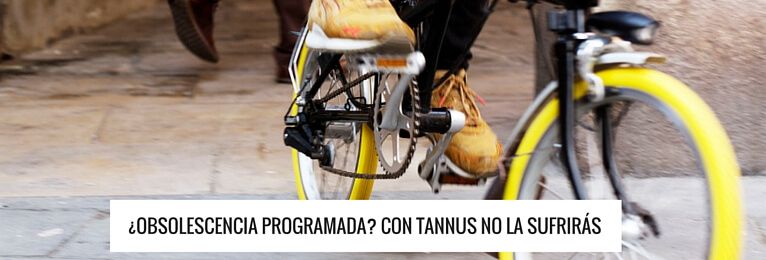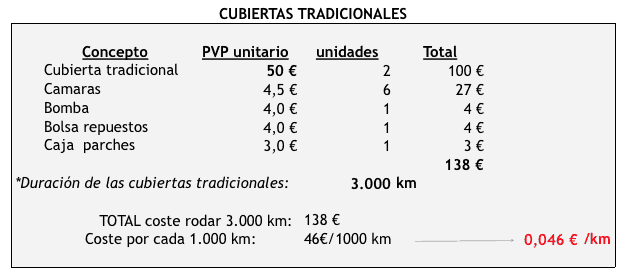Have you ever heard of planned obsolescence? Between you and me, planned obsolescence is a business malpractice we all suffer from. Don't you have the feeling that things used to last longer? Well, this is not just a feeling, it really happens.
In case you haven't heard yet, programmed obsolescence is the business strategy consisting of setting a predetermined date for the death of a product at the time it is launched on the market.
Televisions, cell phones, printers, technology devices in general, fashion and food are victims of programmed obsolescence.
Take it easy! Your Tannus don't have it 😉
As consumers that we are, these bad practices piss us off, and that's why at Tannus we can boast. Not only our products do not have the programmed obsolescence, but we bet for the opposite, to make a product that really brings many benefits to the user and can last longer and longer.
You already know that Tannus' commitment (apart from making you forget about punctures) is to guarantee 6,000 km, but its duration is much longer. We guarantee 6,000 km with optimum performance, but this does not mean that you can no longer use the tires, as this will depend on how demanding you are in terms of comfort and performance. With the Slick road model, you can easily reach 12,000 km, but with the 26" Razor Blade, you can reach 24,000 km!
We don't recommend stretching them that much basically for behavioral reasons, but if you can, you can and you won't have any problems. You see! Long lasting tires - very long lasting! Traditional tires, depending on their quality, last between 2,000 and 3,500 km, so the difference in durability is excellent.
Traditionally, and especially in the food sector, brands fought to set expiration dates as long as possible. However, following the trend of planned obsolescence (very profitable for companies), fast-moving brands realized the advantages they would gain if their products expired early.
I am sure you are familiar with the following example that perfectly exemplifies the behavior of companies in the face of these practices. In the food industry, with the example of yogurts in the lead:
- You're at home with the family and it's time for dessert.
- You open the fridge and see a pack of 8 yogurts, but it's 3 days before they expire!
- What do you do (usually the parents): You ask the whole family to eat all the yogurts as much as possible in the next 2 days.
- Quickly the family, aware of the situation, eats all yogurts.
- Saturday arrives. Shopping list. What's missing? YOGURTES. Let's buy more!
Well, these short expiration dates are the equivalent of planned obsolescence in the industrial world, where the goals of the past were to create high quality, long-lasting products. We have succeeded in doing so! As a consumer, the defense strategy against planned obsolescence would be to buy few units and replace them only when necessary.
Let me link another important aspect also from the point of view of consumer protection and decision making. For some years now we have been seeing how supermarkets have been labeling products not only with the price, but also with the price per gram. This is due to the fact that each brand has different packaging, and therefore different quantities. So that the consumer can make a good decision freely, the information is also given in "euros / kilo" or "euros / gram".
So if a 100ml toothpaste of brand X costs 3.2 euros (0.032 euros per ml). Next to it we see a 200ml brand Y toothpaste at 5.9 euros (0.0295 euros per ml). Which one would you buy? Which one is more expensive? The initial outlay is higher in the second case, but at the same time it is also the cheapest. Being a product of recurrent consumption and without a short shelf life, the most efficient decision as a consumer would be to choose the second brand.
If we link this same case to TannusWhen analyzing the product, we must include in our analysis the euros/km and not simply the final price, since what will give us a real vision is to know how much we will pay for each km.
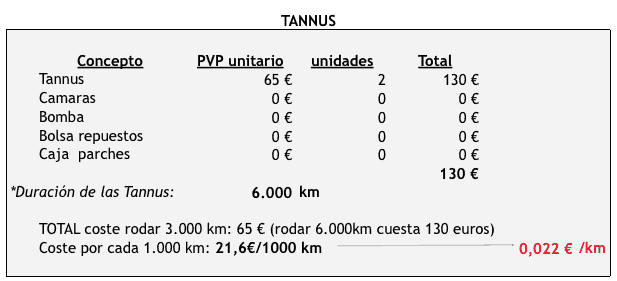
In this analysis there are several scenarios and comparisons with tires of 65€, 50€, 35€ and finally 14€:
- We estimate the price of some inner tubes at 4.5 euros and 4 changes every 3,000 km (total 6 inner tubes: 2 installed + 4 spare).
- Inflation pump 20 euros (amortizing 4 euros every 3,000 km)
- 20 euro spare parts bag (amortizing 4€ every 3.000 km)
- Patch box or other more expensive systems (amortizing 3€ every 3.000 km)
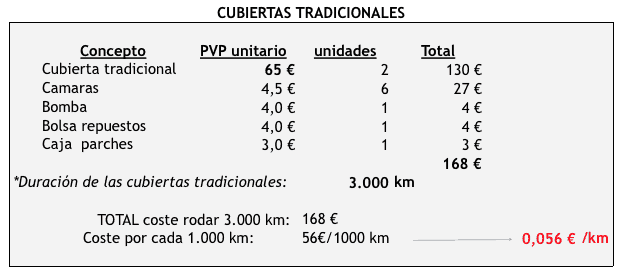
It is concluded that traditional roofs with RRP 65€. are on average 154% more expensive than Tannus.
It is concluded that traditional roofs with RRP 50€. are on average 109% more expensive More than twice as expensive!
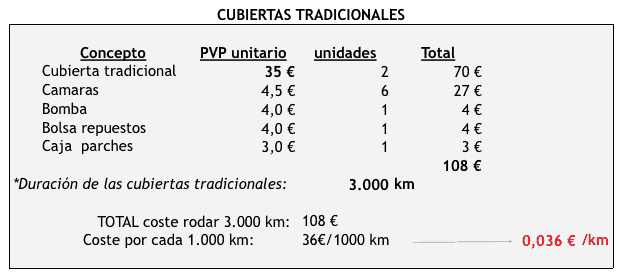
It is concluded that traditional covers with RRP 35€. are on average 63% more expensive than Tannus.
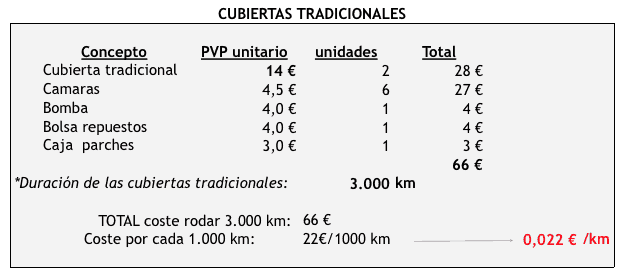
It is concluded that from covers with RRP of 14€., Tannus are starting to pay off.
In this cost study we have not included other factors such as time and comfort, which are also variables that must be evaluated. We will analyze them in a second entry.
And remember that there is no other puncture proof tire on the market, because anything that carries air is susceptible to punctures. The only one that will provide you with a reliable 100% solution is Tannus!




